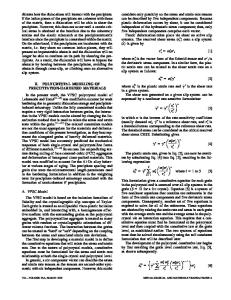Effects of process-control agents on mechanical alloying of nanostructured aluminum alloys
- PDF / 2,167,185 Bytes
- 12 Pages / 612 x 792 pts (letter) Page_size
- 14 Downloads / 391 Views
I. INTRODUCTION
RECENT progress in the studies of bulk amorphous, quasi-crystalline, and nanocrystalline alloys has resulted in substantial improvements in the strength of Al-based alloys.[1–10] Bulk Al alloys with tensile strengths as high as 800 to 1000 MPa and reasonable ductility (2 to 10 pct tensile elongation) have been demonstrated recently.[8,9,10] Many of these Al alloys derive their superior strengths from either a microstructure of nanoscale fcc Al crystals distributed in an amorphous matrix[7,9] or a microstructure containing a mixture of nanoscale fcc Al particles and intermetallic aluminides.[10] However, in some cases, the superior strength comes from a mixed microstructure of quasi-crystalline nanoparticles distributed in a continuous fcc Al matrix.[5,11–13] This group of Al alloys also has excellent strength at elevated temperatures, because of the unusual ability of quasi-crystalline phases in retaining their strength at high temperatures.[12,13] The Al93Fe3Ti2Cr2 alloy is an example of the last group of the Al alloys mentioned previously.[5] This alloy has a mixed microstructure of quasi-crystalline (i.e., icosahedral phase) nanoparticles distributed in a continuous fcc Al phase in the gas-atomized condition, and this mixed microstructure remains unchanged in the extruded bulk alloy.[5] It is shown that the extruded Al93Fe3Ti2Cr2 alloy possesses an ultimate tensile strength of 650 MPa at room temperature and 360 MPa at 300 ⬚C.[5] This high-temperature strength compares very favorably against the current commercial Al alloys, most of which lose their useful strengths at temperatures above 250 ⬚C (typically becoming lower than 200 MPa).[14]
Recently, we have shown that the hardness of the mechanical alloying (MA)–processed Al93Fe3Ti2Cr2 alloy can be twice the hardness of the 6061-Al alloy at the T6 condition and higher than that of the cold-drawn 1045 steel.[15] In this case, however, the high hardness of the Al93Fe3Ti2Cr2 alloy stems from the formation of nanocrystalline supersaturated fcc Al solid solutions. In spite of the high hardness obtained, excessive cold welding of Al particles is observed in the MA-processed Al93Fe3Ti2Cr2 alloy, and this excessive cold welding has resulted in nonuniform microstructures and properties.[15] One of the effective methods to avoid excessive cold welding is the application of surface-active substances, generally known as process-control agents (PCAs). Many researchers have used PCAs to prevent excessive cold welding of Al particles during milling.[16–25] The addition of a PCA, however, could also alter the nature of the milling product,[26] introduce contaminants,[27] and slow down the MA process.[24] In spite of the important role and multiple influences of PCAs in mechanical alloying of ductile materials, most of the studies in the open literature have been devoted to the effect of PCAs on powder-particle sizes and contamination.[24,27,28] Few studies on other effects of PCAs exist in the open literature. Thus, the present study is carried out with two obj
Data Loading...











